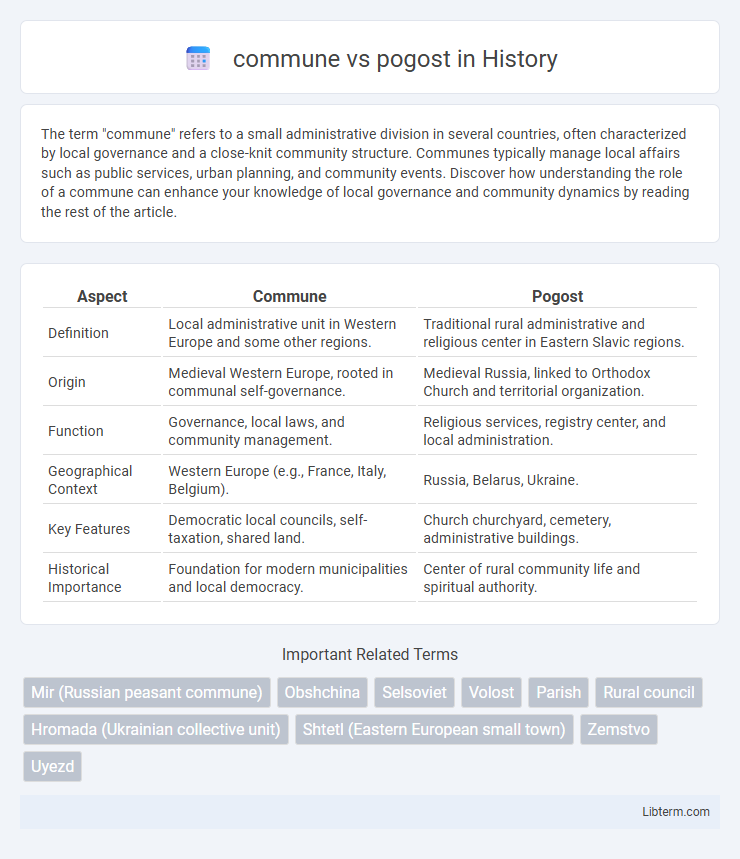The term "commune" refers to a small administrative division in several countries, often characterized by local governance and a close-knit community structure. Communes typically manage local affairs such as public services, urban planning, and community events. Discover how understanding the role of a commune can enhance your knowledge of local governance and community dynamics by reading the rest of the article.
Table of Comparison
| Aspect | Commune | Pogost |
|---|---|---|
| Definition | Local administrative unit in Western Europe and some other regions. | Traditional rural administrative and religious center in Eastern Slavic regions. |
| Origin | Medieval Western Europe, rooted in communal self-governance. | Medieval Russia, linked to Orthodox Church and territorial organization. |
| Function | Governance, local laws, and community management. | Religious services, registry center, and local administration. |
| Geographical Context | Western Europe (e.g., France, Italy, Belgium). | Russia, Belarus, Ukraine. |
| Key Features | Democratic local councils, self-taxation, shared land. | Church churchyard, cemetery, administrative buildings. |
| Historical Importance | Foundation for modern municipalities and local democracy. | Center of rural community life and spiritual authority. |
Definition of Commune
A commune is the smallest administrative division in many countries, typically referring to a local government unit or municipality responsible for local governance, public services, and community regulations. It often consists of a town or village along with surrounding rural areas, functioning as a basic level of territorial organization and political administration. In contrast, a pogost historically refers to an ecclesiastical and rural locality in Russia, centered around a church and its parish community.
Understanding Pogost
A pogost is a historical rural administrative and ecclesiastical area in Russia, often centered around a church or cemetery, distinct from a commune, which is a secular municipal unit or collective farm. Pogosts served as focal points for local religious activities and burial practices, reflecting the cultural and spiritual organization of rural communities in medieval Russia. Unlike communes that emphasize governance and collective agricultural management, pogosts primarily represent religious and territorial divisions rooted in Eastern Orthodox traditions.
Historical Origins of Communes
Communes originated in medieval Europe as self-governing communities designed to protect local rights and properties, often emerging during the decline of feudalism. These entities established charters granting autonomy from feudal lords, fostering collective management of resources and legal systems. In contrast, pogosts, primarily found in medieval Russia, served as ecclesiastical and administrative centers but lacked the autonomous governance characteristic of European communes.
Historical Background of Pogosts
Pogosts historically functioned as administrative and religious centers in medieval Russia, often serving as key hubs for taxation and local governance within rural areas. These settlements typically included a church, a cemetery, and sometimes a wooden enclosure, reflecting their dual role in spiritual life and administrative control. Unlike communes, which emphasize communal living and shared ownership, pogosts were primarily established by princely or ecclesiastical authorities to consolidate territory and organize population for tax collection and church administration.
Structural Differences: Commune vs Pogost
A commune is a modern administrative division with a structured local government, responsible for public services, local regulations, and community development. A pogost historically represents a rural settlement or parish in Russia, often centered around a church and serving as a local religious and social hub. Unlike communes, pogosts lack formal administrative authority and primarily functioned as ecclesiastical and cultural centers in medieval times.
Social and Administrative Functions
Communes serve as fundamental administrative units in many countries, providing essential social services such as education, healthcare, and local governance to residents. Pogosts historically functioned as rural centers in Russia, combining religious, administrative, and social roles, often centered around a church and serving as a hub for local community gatherings and record keeping. While communes emphasize structured local government and service provision, pogosts blend administrative duties with cultural and religious significance in a more decentralized way.
Geographic Distribution in Russia and Eastern Europe
Communes in Russia and Eastern Europe typically represent collective farming communities or administrative units prevalent in rural areas across the region, especially in post-Soviet states. Pogosts, historically rooted in Russian and Slavic territories, are small rural localities often centered around a church or cemetery, primarily found in Northwestern Russia and parts of Karelia. While communes are widespread and linked to agricultural organization, pogosts hold cultural and historical significance concentrated in specific geographic areas.
Evolution Over Time
The evolution of communes and pogosts reflects the transformation of administrative and religious structures in medieval Russia, where pogosts originally functioned as small rural parishes serving both spiritual and local governance roles. Over time, communes emerged as more organized self-governing communities with expanded civil and economic responsibilities, evolving from the decentralized pogost system. This shift marks the gradual development from ecclesiastical-centered administration to more autonomous local municipal governance units in Russian history.
Cultural Significance and Legacy
Communes represent collective agricultural communities that emerged prominently in the 20th century, embodying ideals of shared labor and social equality, often leaving a legacy of communal living practices. Pogosts, historically rooted in Russian tradition, functioned as rural parish centers combining religious, cultural, and administrative roles, preserving Orthodox Christian heritage and local folklore. The cultural significance of communes lies in their influence on modern cooperative movements, whereas pogosts serve as vital repositories of historical architecture and spiritual continuity.
Modern Relevance of Communes and Pogosts
Communes serve as fundamental units of local government and community organization in many countries, facilitating decentralized administration, communal resource management, and local decision-making processes. Pogosts, historically ecclesiastical and rural administrative districts in Russia, have largely lost administrative functions but remain relevant culturally and historically, often serving as centers for heritage preservation and regional identity. Modern relevance of communes lies in their adaptability to contemporary governance needs, while pogosts contribute to the preservation of traditional architecture and serve as focal points for cultural tourism and historical research.
commune Infographic

 libterm.com
libterm.com